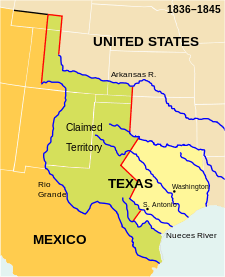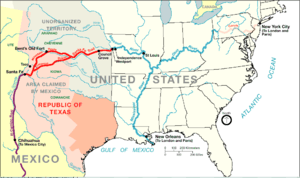Texan Santa Fe Expedition


The Texan Santa Fe Expedition was a commercial and military expedition to secure the Republic of Texas's claims to parts of Northern New Mexico for Texas in 1841.[2][3] The expedition was unofficially initiated by the then President of Texas, Mirabeau B. Lamar, in an attempt to gain control over the lucrative Santa Fe Trail and further develop the trade links between Texas and New Mexico. Lamar had already started courting the New Mexicans, sending out a commissioner in 1840, and many Texans thought that they might be favorable to the idea of joining the Republic of Texas.
The expedition set out from Kenney's Fort near Austin on June 19, 1841. The expedition included 21 ox-drawn wagons carrying merchandise estimated to be worth about $200,000. Among the men were merchants that were promised transportation and protection of their merchandise during the expedition, as well as commissioners William G. Cooke, Richard F. Brenham, José Antonio Navarro, and George Van Ness. Although officially a trading expedition, the Texas merchants and businessmen were accompanied by a military escort of some 320 men. The military escort was led by Hugh McCleod and included a company of artillery.
The journey to New Mexico during the summer was blighted by poor preparation and organization, sporadic Indian attacks, and a lack of supplies and fresh water. After losing their Mexican guide, the group struggled to find its way, with no one knowing exactly how far away Santa Fe even was. McCleod was eventually forced to split his force and sent out an advance guard to find a route.

The expedition finally arrived in New Mexico in mid-September 1841. Several of their scouts were captured, including Capt. William G. Lewis. Having expected to be welcomed on their arrival, the expedition was surprised to be met by a detachment from the Mexican Army of about 1500 men sent out by the governor of New Mexico, Manuel Armijo. One of Armijo's relatives who spoke English, probably Manuel Chaves or Mariano Chaves, parleyed with the Texans, with Captain Lewis supporting his statements. Both said that Armijo would give the Texans safe conduct and an escort to the border, and Lewis swore to it "on his Masonic faith".[4] After the Texans' arduous journey, they were in no state to fight a force that outnumbered them so heavily, so they surrendered. The New Mexicans gave them some supplies.
However, the following morning, Armijo arrived with his army, had the Texans bound and treated harshly, and demanded the Texans be killed, putting the matter up to a vote of his officers. That night, the prisoners listened to the council debating the idea. By one vote, the council decided to spare the Texans. The latter were forced to march the 2,000 miles from Santa Fe to Mexico City. Over the winter of 1841-42, they were held as prisoners at the Perote Prison in the state of Veracruz, until United States diplomatic efforts secured their release.[5]
After the surviving Americans were released on June 13, 1842, one of the prisoners, Robert D. Phillips, wrote to his father that: "Many of the men are waiting only for the party of a man named Cook to arrive so they may continue on to Vera Cruz and then to New Orleans.[6] The men found their way to New Orleans on board various ships, among them the Henry Clay, which, according to the ship's manifest, arrived in New Orleans on September 5, 1842, carrying 47 "Volunteers of the Texan Army Santa Fe Prisoners."
Some members of the Santa Fe Expedition
Source: Ship's Manifest for the Henry Clay, September 5, 1842:
- B. M. Bonner age 30,
- F. M. Daupthan or Daupthian age 25,
- ? Hubbard age 26,
- I or J. M. Gray age 22,
- P. Shultz age 24,
- N. Lee age 26,
- D. F. Shaw age 31,
- Q. H. Lee age 26,
- P. Yarborough age 25,
- J. L or G. Hass age 28,
- J. M. Fraywich or Feagwich age 34,
- F. H. Berne age 31,
- G. M. Carter age 29,
- J. Richardson age 22,
- H. Cabamo or simply “Alabama” age 25,
- G. N. Burk or Bund age 23,
- G. Price age 22,
- J. C. Leriot age 26,
- J. Basset or Barret age 27,
- S. T. Porter age 26,
- J. Cummings age 25,
- H. Chustrvelle or Cheesw?elle age 24,
- N. F. Mars age 25,
- D. Rookes age 27,
- C. Ray age 22,
- J. B. Cunsay or Ceansay age 29,
- J. S. Weiss age 31,
- J. Broady age 27,
- D. L. Cane age 31,
- J. Phlelps age 24,
- B. B. Bager or Bayer age 23,
- F. Eager age 22,
- J. Gonison ? age 26,
- Ths Bens age 26,
- J. Shelby age 25,
- M Able age 24,
- M. Thompson age 23,
- B. Kenedy age 28,
- J. Adair age 27,
- [No initial] Peterson age 27,
- [No initial] McPherson age 28,
- [No initial] Cass age 29,
- [No initial] Stanley age 24,
- John Rhan age 26,
- A. Mells age 25,
- C. Wolf age 25,
Aftermath
Lewis was widely considered a traitor, but the options facing the Texans were stark, and standing and fighting would almost certainly have led to their annihilation. Furthermore, there is no information on whether Lewis or Chaves knew Armijo's real intentions.
Lamar was widely held responsible for the disaster and the expedition tarnished his presidency. The controversy over the prisoners helped to increase tensions between the United States and Mexico, leading up to the Mexican-American War.[7]
In popular culture
The expedition forms the backdrop to Larry McMurtry’s novel Dead Man's Walk, which is part of the Lonesome Dove series.
A Texas Ranger is mentioned as being a "Santa Fe expeditioner" in The Lone Ranch: A Tale of the Staked Plain (1860) by Capt. Thomas Mayne Reid, having "spent over twelve months in Mexican prisons."
Notes and sources
- ↑ "Sante Fe National Historic Trail Map" (PDF). National Park Service. Retrieved 2008-07-20.
- ↑ "Santa Fe Expedition". Lone Star Junction. 1998. Retrieved 2008-08-09.
- ↑ Kendall, George Wilkins (1846). Narrative of the Texan Santa Fe Expedition: Comprising a Tour Through Texas and Capture of the Texans. London: Sherwood, Gilbert, and Piper. Retrieved 2007-07-08.
- ↑ Simmons, Marc (1973). The Little Lion of the Southwest: a life of Manuel Antonio Chaves. Chicago: The Swallow Press. ISBN 978-0-8040-0633-0.
- ↑ Seymour V. Connor, "PEROTE PRISON," Handbook of Texas Online (http://www.tshaonline.org/handbook/online/articles/jjp02), accessed February 22, 2015. Uploaded on June 15, 2010. Published by the Texas State Historical Association.
- ↑ Phillips, Robert D. (1842–1844). Phillips Family Texan Santa Fe Expedition Letters and Documents. University of Texas Arlington Library: Unpublished.
- ↑ Texan Santa Fe Expedition at Lone Star Junction website
External links
| Wikiquote has quotations related to: Narrative of the Texan Santa Fé Expedition |
- Texas and part of Mexico & the United States : showing the route of the first Santa Fé expedition / drawn & engd. by W. Kemble., published 1850, hosted by the Portal to Texas History.
- Texan Santa Fe Expedition
- Online Handbook of Texas
- Thomas Falconer's account from the Sons of Dewitt Colony Texas, accessed June 30, 2006
- Chapters 13–16 of George Kendall's Narrative of the Texan Santa Fe Expedition from the Sons of Dewitt Colony Texas, accessed June 30, 2006
- Phillips Texan Santa Fe Expedition Letters and Documents
| ||||||||||||||||||